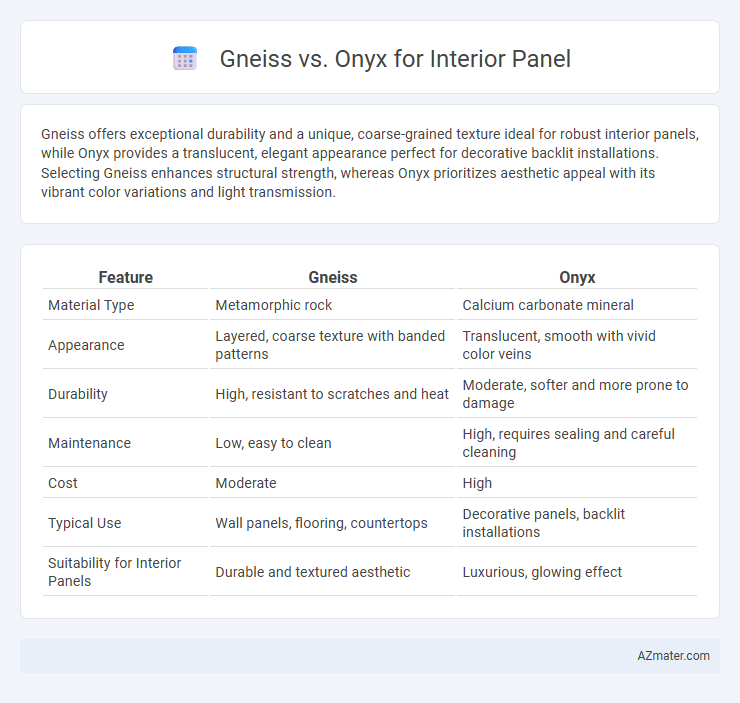Gneiss offers exceptional durability and a unique, coarse-grained texture ideal for robust interior panels, while Onyx provides a translucent, elegant appearance perfect for decorative backlit installations. Selecting Gneiss enhances structural strength, whereas Onyx prioritizes aesthetic appeal with its vibrant color variations and light transmission.
Table of Comparison
| Feature | Gneiss | Onyx |
|---|---|---|
| Material Type | Metamorphic rock | Calcium carbonate mineral |
| Appearance | Layered, coarse texture with banded patterns | Translucent, smooth with vivid color veins |
| Durability | High, resistant to scratches and heat | Moderate, softer and more prone to damage |
| Maintenance | Low, easy to clean | High, requires sealing and careful cleaning |
| Cost | Moderate | High |
| Typical Use | Wall panels, flooring, countertops | Decorative panels, backlit installations |
| Suitability for Interior Panels | Durable and textured aesthetic | Luxurious, glowing effect |
Introduction to Gneiss and Onyx
Gneiss, a durable metamorphic rock with distinct banding caused by mineral segregation, offers excellent structural strength for interior panels. Onyx, a translucent carbonate stone characterized by unique swirling patterns and vibrant color variations, provides a luxurious aesthetic ideal for feature walls and backlit installations. Both materials are valued in interior design for their natural beauty and ability to enhance visual appeal, with gneiss favored for durability and onyx prized for its decorative qualities.
Geological Origins and Formation
Gneiss, a metamorphic rock formed from high-grade regional metamorphism of granite or sedimentary rock, is characterized by its foliated texture and banded appearance due to mineral segregation during intense heat and pressure. Onyx, a variety of chalcedony formed through the deposition of silica from groundwater in layered bands within caves, exhibits a smooth, translucent surface with striking parallel bands. The geological origins of gneiss and onyx result in distinct structural properties, with gneiss offering durability and natural Veining patterns, while onyx provides a luxurious, luminous finish suited for aesthetic interior panels.
Appearance and Aesthetic Appeal
Gneiss features a coarse-grained texture with interlocking crystals that range from light gray to pink, offering a natural, earthy elegance ideal for interior panels. Onyx, on the other hand, displays a translucent quality with vibrant bands of color such as amber, white, and green, creating a luxurious and dramatic aesthetic. The choice between gneiss and onyx for interior panels depends on whether a more rugged, natural look or a polished, striking visual impact is desired.
Durability and Strength Comparison
Gneiss offers exceptional durability and strength due to its coarse-grained texture and high mica content, making it highly resistant to wear, scratches, and heat, ideal for high-traffic interior panels. Onyx, while visually striking with its translucent and vibrant patterns, is softer and more brittle, requiring careful handling and maintenance to avoid cracking or chipping under impact. In terms of long-term structural integrity for interior panels, gneiss outperforms onyx by providing greater resistance to physical stress and environmental factors.
Maintenance Requirements
Gneiss interior panels require minimal maintenance due to their high durability and resistance to scratches, stains, and heat, making them ideal for long-term use in high-traffic areas. Onyx panels, though visually striking with their translucency and vibrant patterns, demand careful maintenance involving regular sealing and gentle cleaning to prevent staining and surface damage. Choosing between gneiss and onyx for interior panels depends on balancing the need for low maintenance with the desired aesthetic impact.
Cost and Value Considerations
Gneiss offers a more cost-effective solution for interior panels due to its abundant availability and lower quarrying expenses, making it ideal for large-scale projects. Onyx commands a higher price because of its rarity, translucency, and unique veining, which adds luxurious aesthetic value and can justify the premium investment. Choosing between gneiss and onyx depends on budget constraints and the desired impact, balancing durability and exclusivity for long-term interior value.
Installation Process and Challenges
Gneiss offers durable and stable properties for interior panels, often requiring precise cutting and careful handling due to its coarse-grained texture, which can pose installation challenges such as chipping or uneven surfaces. Onyx, known for its translucent beauty, demands meticulous backlighting integration and delicate mounting to prevent cracking, making installation more labor-intensive and requiring specialized adhesives and support systems. Both materials call for skilled installers familiar with natural stone characteristics to ensure seamless fitting and long-term performance in interior panel applications.
Environmental Impact and Sustainability
Gneiss, a natural metamorphic rock, offers durability and low maintenance with minimal environmental disturbance due to its abundant availability and local quarrying. Onyx, prized for its translucency and aesthetic, often involves energy-intensive extraction and synthetic enhancements, raising concerns about its carbon footprint and sustainability. Choosing gneiss for interior panels supports eco-friendly building practices by reducing transportation emissions and promoting the use of long-lasting materials.
Best Applications for Each Stone
Gneiss offers exceptional durability and heat resistance, making it ideal for fireplace surrounds, kitchen countertops, and high-traffic wall panels where strength and longevity are essential. Onyx, prized for its translucent beauty and unique veining, is perfect for accent walls, backlit feature panels, and decorative installations that emphasize luxury and visual impact. Choosing gneiss ensures practical performance and ruggedness, while onyx provides an elegant statement with its exotic appearance in low-wear environments.
Choosing the Right Material for Your Space
Gneiss offers durability and a unique, natural texture with its layered mineral composition, making it ideal for high-traffic interior wall panels that require strength and aesthetic appeal. Onyx provides a luxurious, translucent quality with vibrant veining that enhances ambient lighting, perfect for accent walls or feature panels where elegance is a priority. Selecting the right material depends on balancing onyx's visual drama and softer durability against gneiss's robust structure and earthy sophistication to suit the specific functional and design needs of your space.

Infographic: Gneiss vs Onyx for Interior Panel
 azmater.com
azmater.com